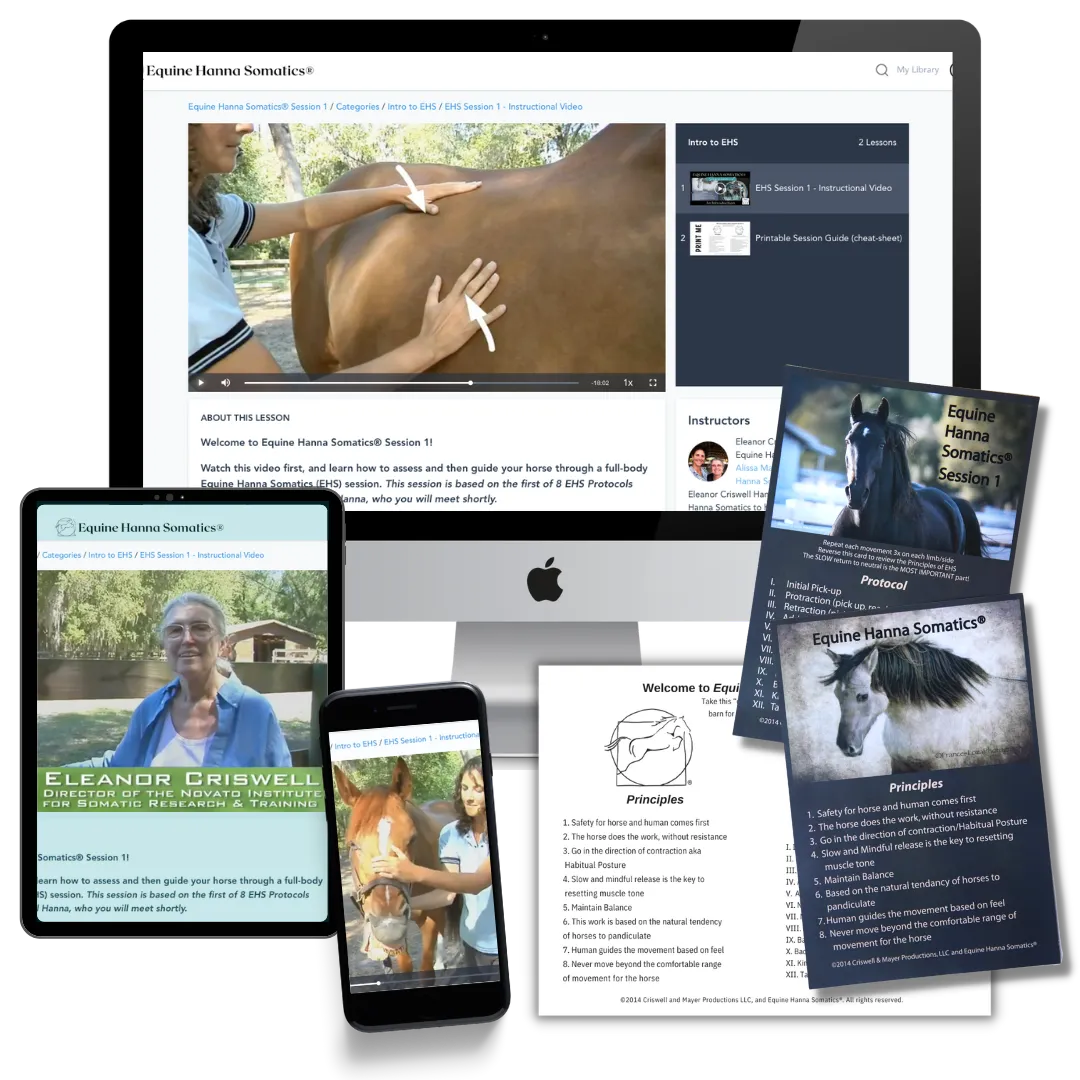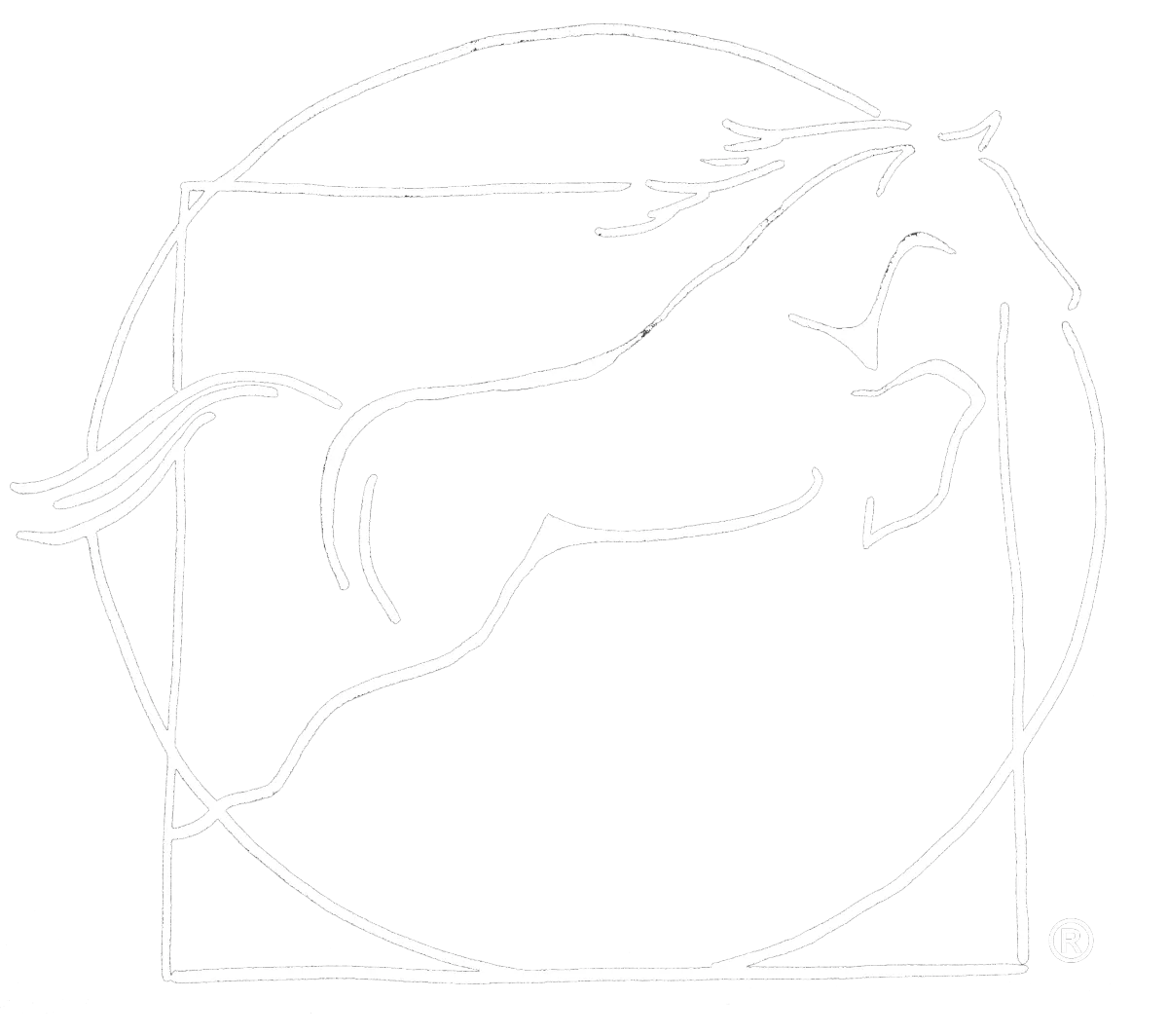Assessing Outcomes of Equine Hanna Somatics
To put it as simply as possible, the main objective outcome of Hanna Somatics, regardless of the species doing the movements (horse, dog, human, etc.) is to cause an internally mediated normalization of habitual resting muscle tonus, thereby allowing the individual to return to the natural state of automatic organization, self-carriage and self-regulation of a healthy, living biotensegrity system, free from the affects of motor sensory amnesia.
How does EHS work?
We achieve this by inviting each individual to temporarily change the level of brain control over their skeletal muscles during a series of somatic exercises, following a unique set of principles (founded in basic neuroscience) that specifically engage the voluntary motor cortex area of the brain to control the somatic movements. There are many different parts of the brain and spinal cord that are involved in triggering or controlling muscle contractions, but only impulses from the voluntary motor cortex can dynamically influence the de-contraction (aka lengthening or ‘relaxation’) of the muscles, which allows the nervous system to ‘reset’ the default resting length of each muscle, aka the resting muscle tonus, or tone. Immediately after finishing the somatic exercises, conscious movement control is relinquished and given back to the body’s incredibly advanced autopilot system.
Long-lasting Changes in Resting Muscle Tone
The changes in resting muscle tone levels that result from Hanna Somatics are both immediate and very long-lasting, with noticeable improvements during and after the very first session, and results that generally persist and cumulatively improve over the following days, weeks, months and even years!
Ideally, resting muscle tone should be maintained at the lowest possible level to efficiently maintain the body’s tensegrity and attention or ‘readiness to move’ - without wasting energy or reducing the available length or strength of the skeletal muscles. Unfortunately, over time and repeated exposure to stressors, horse and humans alike tend to accumulate chronic tension in layers as part of our adaptive responses to daily life. So every Hanna Somatic session begins with a pre-assessment of posture, movement and range-of-motion to gather information about which skeletal muscles are experiencing abnormal resting tone.
In Equine Hanna Somatics, deviations in normal resting muscle tone are subjectively observed and measured in three ways:
Visual inspection of static posture, body organization, muscular development/tone, asymmetries, facial expression and overall wellness. Like people, horses tend to develop global patterns of chronic muscle contractions that produce one of three characteristic habitual postures (or combinations of these postural patterns) often accompanied by co-contractions that create areas of excessive stiffness.
Visual inspection of movement at the walk from various viewpoints, observing dynamic posture and body organization, movement quality in key areas, range-of-motion, length of stride, limb trajectory, etc. and overall wellness. The movement (or lack of normal movement) will reflect the areas where shortened muscles are not allowing full joint range-of-motion or are actively pulling the limbs or axial skeleton out of neutral alignment.
Hands-on assessments of joint Range-of-Motion and Palpation of resting muscle tone in palpable muscles with a gentle, flat-finger technique are included before, during and after each session for confirmation of muscle tone or ROM changes, observing pain signals or areas of discomfort, texture, temperature, etc.
Objective vs. Subjective Markers
Due to both the nature of working with horses outside of a laboratory setting, and to the very rapid changes observed in horses posture and muscle tone during and following any EHS exercises or sessions, we do not frequently utilize any objective measurements or markers (like measuring joint angles or the degree of drop or ‘sway’ in the horses back) for assessing outcomes. The exception is taking before/after photos and videos to track progress and record postural patterns and changes over time.
During and after each EHS session, changes in muscle tone are continually observed with the same three techniques described above - by assessing the changes in static posture, changes in movement quality/ability, and by palpating the muscles directly.
Top Subjective Markers of Improvement post-EHS:
Improvements in Global Postural Organization as the whole body is systematically freed from the constant pull of various chronically shortened muscles, and released from the associated reflexive inhibition of the opposing muscles or muscle groups, tensegrity is restored and the automatic postural reflexes are able to resume their unconscious self-regulation and balancing functions.
Postural improvements are immediately noticeable in both the Static Posture (resting stance) and Dynamic Posture (in movement) during and after an EHS session. Visually apparent reductions of various postural deviations are observed by noting: the horse being more squarely balanced over all four limbs with the cannon bones more vertical and the joints bending appropriately, the head and neck held lower, the neck becoming longer and more arched, the back becoming more neutral, less extended or less roached, changes in shoulder and pelvic angles, decreased lateral spinal asymmetries or deviations in axial rotation, appropriate engagement of the thoracic sling muscles, and more…
Improved Range-Of-Motion - Muscles with a neutral resting tonus are effortlessly able to contract to produce forces and to lengthen to their maximum natural length as needed during movement.
This is visually apparent when watching the horse move during and after the EHS session, and noticeable via feel during subsequent hands-on EHS exercises or passive range-of-motion or meanswhereby movements, as well as noted by riders post-EHS. Specifically you many note changes in length of stride, a return to a healthy ‘J’ swing of the head at the walk, increased rotation of the scapula, more oscillating mobility through the barrel and lumbo-sacral areas, easier/deeper breathing, less preference for bending or traveling more in one direction or on a particular lead in canter, ease in getting down to roll, rolling over more easily and ‘popping effortlessly back to their feet’ and general improvements in performance and organization.
Normalization of the Palpable Tone of individual muscles - As the resting muscle tone returns to a normal neutral, muscles that looked, felt and performed abnormally immediately improve as they are freed from the internal compression or reflexive reciprocal inhibition produced by chronic muscle contractions.
The chronic contraction and shortened position of a muscle (or group of muscles) with elevated resting tonus is clearly palpable - a muscle with high tone will feel hard, may bulge or be flat, dry or ‘ropey’ with little give, and may appear overdeveloped (hypertrophic) or atrophied, depending on the level of tone the duration of the chronic contraction, which can persist for days, weeks, months, years or longer.
Developing Feel
With practice, it is possible to highly educate your eye and your hands by building your personal sensory library. Observe and palpate as many horses as you can! Even without much practice, most people can immediately feel the changes in resting muscle tone using the Goldilocks principle (noting muscles that feel too hard, too soft, or ‘just right’) and by comparing the feel of muscles before and after a specific somatic exercise or a full EHS session. EHS Educators (what we call our student and certified practitioners) often encourage the horse owner to participate in the palpation assessments before and after EHS sessions.
Additional Benefits of Equine Hanna Somatics
The many other benefits of EHS (improvements in endurance, performance, learning/trainability, willingness, self-carriage, hoof balance, relaxation, overall health, well-being and happiness; reductions in pain, stiffness, behavior issues, stereotypies/vices, injuries; the ‘spontaneous’ resolution of mysterious or undiagnosed lameness issues; increased bonding with the owner/trainer/handler, improved social interactions, actualization of intelligence and performance potential, reclamation of lost social status within the herd - and more!) are frequently owner-reported observations.
EHS has applications across the full spectrum of equine health, training and management...
From helping horses with severe lameness or persistent compensation patterns that nothing else is able to solve, to reversing many of the symptoms of ‘aging’ that cause loss of performance, end athletic careers or create unnecessary suffering for horses in their golden years, to preventing future injuries, offering sound and healthy horses a faster track to living up to their potential, EHS offers a fast-track to helping horses become their ‘best-selves’ or what we call Actualized.
EHS is a gentle, natural approach that is extremely complimentary to all other training, treatment or therapeutic methods and with very few contraindications. Because it is based on proven neuroscience and neuromuscular physiology, and requires that the horse actively participates in the work (not just yawning or ‘releasing, or giving feedback about what it likes or where it does or does not want you to ‘work’ next) - it is easy to learn, safe and effective for all ages and stages of horses.
We want every domestic horse in the world to experience the profound relaxation and interspecies bonding that results from this revolutionary work. So we’re on a mission to teach every horse owner, rider, trainer and animal lover how to guide their horses through some basic EHS exercises that can be easily integrated into any grooming or training routine. You can learn 3 of our favorite somatic exercises for every horse in the free eBook available here, or scroll down to purchase our introductory course, which teaches a basic full-body EHS session, how to assess your horse before and after EHS, and includes a short introductory lesson on how to do Hanna Somatics with your own body too!
REFERENCES
Kopecká, B., Ravnik, D., Jelen, K., & Bittner, V. (2023). Objective Methods of Muscle Tone Diagnosis and Their Application-A Critical Review. Sensors (Basel, Switzerland), 23(16), 7189. https://doi.org/10.3390/s23167189
Tabor, G., & Williams, J. (2020). Objective Measurement in Equine Physiotherapy. Comparative Exercise Physiology, 16(1), 21-28. https://doi.org/10.3920/CEP190049
Sharp, Y. (Jan 12, 2023). Neuro-Bio-Tensegrity, the Push Puppet Effect, The Equine Documentalist https://www.theequinedocumentalist.com/post/neuro-bio-tensegrity-the-push-puppet-effect
Criswell, E. & Mayer, A. (2006-2025) Equine Hanna Somatics® Professional Training Program Manual




